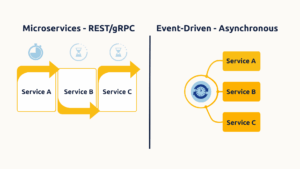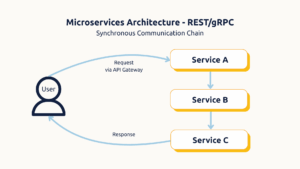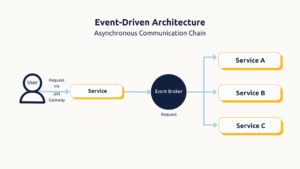Event-driven architectures and microservices architectures are two ever-popular approaches. As far back as 2021, Solace, a major event-streaming middleware platform, was reporting widespread adoption.
‘According to a Solace-commissioned survey of 840 people in 9 countries across the globe, 85% of organisations have turned to event-driven architecture to meet their business needs.’
Microservices, on the other hand, are just as ubiquitous. Event-driven architecture vs. microservices architecture remains a commonly queried topic, however, partially due to an old habit of teams treating microservices as synonymous with synchronous architecture (a tongue twister if there ever was one). In this piece, we disentangle the two, weigh up the pros and cons, and give our take on which is the better route for those building a SaaS application in 2025.
What’s the difference between event-driven architecture and microservices architecture?
While the two are often mentioned as an either/or, event-driven architecture and microservices architecture refer to different approaches which are, in fact, perfectly compatible.
Microservices means an architectural pattern that breaks an application into independent services, each often responsible for a specific business function.
Event-driven architecture, on the other hand, is a communication style – one where services react to events in real-time through asynchronous communication. Many teams build event-driven, microservices-based applications, combining the modularity of microservices with the responsiveness of event streams.
So why the vs. framing?
When microservices first exploded in popularity, many teams implemented via REST (and later gRPC) APIs; this led to tightly coupled services communicating synchronously.
Event-driven architectures, on the other hand, are asynchronous.
In the former, one service must wait for the next to respond before making another call. In the latter, the service pushes the event to a broker (which other services monitor) and is then free to push more events.
So, what people often mean when they say microservices vs. event driven is really REST/gRPC vs. event driven. And that’s what we’re going to explore.

What is microservices architecture (REST/gRPC-based and synchronous)
If you built your SaaS application as microservices, this is likely the communication pattern you employ (or at least started with, depending on when you first architected your system).
This pattern sees autonomous services – often split by business function – communicate via synchronous request-response (e.g., REST/JSON over HTTP or gRPC/Protobuf over HTTP/2) through well-defined APIs.
It’s a widely adopted pattern in SaaS – simple to implement, well-supported by tooling, and easy to reason about. However, it’s also fragile due to its more tightly coupled services.
Essentially, synchronicity creates a chain of dependencies, undermining microservices’ goal of multiple services scaling independently.
Advantages of microservices architecture (REST/gRPC-based and synchronous)
- Simple request-response communication that’s easy to design, implement and debug
- Well-defined APIs support service independence and team ownership
- Strong tooling support across most modern applications and technology stacks
- Suits workflows that require immediate confirmation, like account management or payments
Disadvantages of microservices architecture (REST/gRPC-based and synchronous)
- Tight coupling between services can lead to cascading failures if one service fails
- Harder to scale independently based on traffic or performance needs
- Chined synchronous communication increases latency and reduces service independence
- Requires careful management of retries, timeouts and data consistency
Use cases for microservices architecture (REST/gRPC-based and synchronous)
This model suits SaaS platforms with linear, request-driven workflows – like user onboarding, subscription management, or simple CRUD operations – where services can communicate directly and in sequence. It’s often a strong fit for early-stage products where teams benefit from straightforward request handling and minimal orchestration.
On the other hand, the simplicity of synchronous communication can be a boon in highly regulated industries where consistency and predictability are paramount.

What is event-driven architecture?
As SaaS platforms mature and system demands increase, event-driven architecture (EDA) is becoming a popular next step.
While synchronous systems rely on services calling each other directly, EDA introduces a fundamentally different model: services communicate by producing and consuming events, rather than waiting on direct responses.
In this model, when an event occurs – say, a user updates their profile or a payment is confirmed – that event is published to a central event stream or broker (e.g., Kafka, RabbitMQ, NATS, Pulsar). From there, event consumers – such as notification services, billing, or analytics – independently process events in real time, often in parallel. This asynchronous communication decouples services, allowing them to operate, fail, and scale independently.
While not a silver bullet, event-driven architecture introduces the flexibility and responsiveness many SaaS teams need as they scale. The downside, as with many approaches that increase system complexity, is that these applications are harder to debug, trace and understand.
Advantages of event-driven architecture
- Because events are asynchronous, services can react independently and concurrently, improving system responsiveness and throughput
- Decoupling through event streams enables not just independent scaling, but greater flexibility in deployment, versioning, and service ownership
- Since consumers pull events when ready, one service failing won’t block others – improving fault isolation and system resilience
- If designed for it, event streams can feed real-time analytics and complex event processing, though this requires additional design effort and specialised tooling
Disadvantages of event-driven architecture
- Because services don’t communicate directly, understanding system behaviour requires strong observability and is harder to reason about
- Asynchronous flows make it more difficult to enforce ordering, coordinate complex transactions, or guarantee data consistency
- Decoupling increases architectural complexity, requiring careful management of schemas, retries, and event versioning
- Testing becomes more involved, as effects may be delayed, distributed, or triggered by past events across multiple consumers
Use cases for event-driven architecture
This model suits SaaS platforms where a single user action needs to trigger multiple outcomes – such as metering usage, sending notifications, updating third-party integrations, or logging events for compliance. It’s a strong fit for products that offer complex internal automation, rely on usage-based pricing, or provide real-time insights at scale.
However, teams don’t need to wait to adopt event-driven systems. A billing platform or a logistics tool – any situation where you have multiple services reacting to the same event or handling downstream outcomes – would likely architect this way from the beginning.

How we can help
Whether you’re a mature SaaS product team wanting to transition to event-driven architecture or a start-up building its platform for the first time, we’ve got you covered.
At Just After Midnight, we’ve helped major B2B and B2C products deliver a quality service via our managed cloud, platform engineering and signature 24/7 full-stack support for SaaS service.
Just read about our work with UK national treasure Joe Wicks’ The Body Coach App or LineTen’s global journey planning solution.
So, if you need help cutting cloud costs, ensuring reliability or evolving your architecture, just get in touch.



